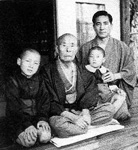Koizumi family

The Koizumi family has been prominent in Japanese politics since the early 1900s. Notable members of this family include:
- Matajirō Koizumi (1865–1951) – Minister of Posts and Telecommunications, he was known as the "wild man" and "tattoo minister" because of a large dragon Irezumi tattoo on his back.[1] While many other politicians of his era descended from the samurai class, Matajirō's father Yoshibe Koizumi was a scaffolder and commoner.
- Jun'ya Koizumi (1904–1969) – Son-in-law of Matajirō. Served as Director General of the Japanese Defense Agency.[citation needed]
- Tetsugoro Iryo (1924/25–1945) – nephew of Jun'ya and cousin of Junichirō Koizumi, died a kamikaze pilot.
- Junichirō Koizumi (born 1942) – son of Jun'ya and grandson of Matajirō. Former Prime Minister of Japan.[2]
- Kayoko Miyamoto (born 1957?) – ex-wife of Junichirō Koizumi.[3]
- Kotaro Koizumi (born 1978) – actor, eldest son of Junichirō.[4]
- Shinjirō Koizumi (born 1981) – politician, second son of Junichirō.[5]
- Yoshinaga Miyamoto (born 1982) – third son of Junichirō, has never met his father.[3][6]
- Jun'ya Koizumi (1904–1969) – Son-in-law of Matajirō. Served as Director General of the Japanese Defense Agency.[citation needed]
References
- ^ Jake Adelstein (19 October 2012). "Japan's Justice Minister to Resign Over Yakuza Ties". The Daily Beast. Retrieved 9 February 2016.
- ^ Justin McCurry (10 November 2003). "An encore for Japan's first Elvis-impersonating PM". The Guardian. Retrieved 9 February 2016.
- ^ a b Valerie Reitman (2 October 2001). "Divorce, Japanese Style". Los Angeles Times. Retrieved 9 February 2016.
- ^ "Japanese PM's son seeks limelight". BBC News. 1 August 2001. Retrieved 9 February 2016.
- ^ Yuri Kageyama (18 August 2009). "Prime minister's son struggles in Japan election". San Diego Union-Tribune. Retrieved 9 February 2016.
- ^ Kathryn Tolbert (19 May 2001). "For Japanese, a Typical Tale of Divorce". The Washington Post. Retrieved 9 February 2016.












